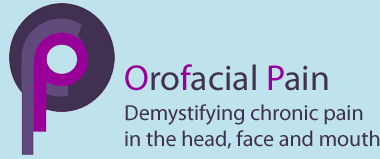
About
Pain in the head, neck and mouth region is a common affliction, affecting up to 26% of the population. Acute pain is a protective reflex in health and stops us damaging ourselves. In addition once injured the increased sensitivity from the swelling (inflammation) caused by the region helps to remind us to protect the region from unnecessary movement and further trauma thereby helping maximise healing capacity. If the pain persists beyond the healing phase it is known as “chronic” pain. If chronic pain develops it is thought that a large proportion of this type of pain is due to subtle changes in the peripheral and central nervous system that mean the pain sensing nerves (nociceptors) process normal and painful information differently.
A good explanation of how pain can become chronic can be found on Youtube:
We are therefore evolutionarily programmed to interpret pain as a warning sign of tissue being damaged and often protective reflexes will ensue. The fact is that we now understand it is possible to have pain without visible damage or pathology and science is beginning to unpick the nerve-based mechanisms behind this.
The facial region contains structures vital for living: eyes for sight, mouth for breathing, communicating and eating, and ears for hearing. In addition the essential organ, the brain, is also obviously in close proximity. It should be of no surprise, therefore, that any threat of damage to this region is likely to initiate primitive survival instincts and this may amplify the psychological and physiological consequences of pain in this region. This coupled to the level of sensory supply to the face probably helps explain the highly distressing nature of pain in this region.
This partly explains as to why pain in the orofacial region causes such fear and emotion in patients. The face and head include many structures (ears, joints, eyes, sinuses, teeth to name a few) so it’s often very complicated getting the diagnosis right. It takes time and patience, a multidisciplinary team and plenty of support.
About us
This video gives a brief introduction to the team who are behind this website and its aims:
With this website we hope to unravel some myths about pain in the face, mouth, head and neck, we hope you find this site useful in providing you up to date info about your condition.
Do feedback to us any comments you may have as we would be interested to hear your opinion.
Mission statement
Supporting patients by:
- Making education more accessible for patients about chronic pain in the head face and mouth
- Providing support for patient groups who are not already ‘catered’ for (TNA and Ouch)
- Speeding up referrals thus expediting care for patients with neuropathic pain if treated early on may improve resolution rate and pain relief.
- Providing summarized patient demographics, relevant history, pain, functional and psychological profiling prior to consultation saving valuable time.
Informing clinicians involved in orofacial pain management by:
- Making education more accessible for clinicians about chronic orofacial pain
- Improving access to optimal specialist OFP services in localized MDTs where possible.
- Improving support for clinicians encountering patients with chronic OFP
- Identifying urgent need for patient care with red flag system highlighting urgent need
Raising finance (sponsorship)
- We are a non-profit organisation
- if you are a visitor, patient or clinician, to the site and you have found the information that we have provided helpful please donate to us
- if you are an institution who would like to link to our site please email us at info@orofacialpain.org.uk
- If you are a lawyer or other professional using the site for information for reports or other work please donate and support the continued development of the site
- Those interested in training please email us at info@orofacialpain.org.uk
- Those interested in research participation or collaboration, we have plenty of projects ongoing, do contact us

